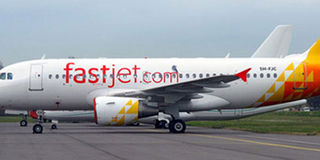Why low-cost flights can be very expensive

Fastjet, Africa’s low-cost airline, serves east and southern Africa. FILE PHOTO
What you need to know:
Generally, low-cost carriers will fly short haul and medium haul routes from several airports, with a high density or high passenger demand, so as to avoid competition with full-service carriers. Michael Otieno points out that if low-cost carriers should imply travel cost savings, why isn’t that benefit evident?
In the recent past, we have been hearing about how air travel and connectivity within the region is getting better through low-cost or budget carriers.
However, don’t go into a celebratory mood just yet.
A spot check on the website of a recently launched low-cost carrier put the one-way fare between Nairobi and Dar es Salaam at approximately $80 (Shs269,440).
The same search done, with the same exact parameters, on the website of a full-service carrier revealed a fare of $89 (Shs299,752). So, if by name alone “low-cost carrier” should imply travel cost savings, why isn’t that benefit evident?
Let us take a look at another scenario: Nairobi to Mombasa, arguably one of the most heavily travelled routes in the region, is approximately an hour’s flight.
A flight search within the month, done one to two weeks in advance, will give you an average one-way fare (inclusive of all taxes) of $60 (Shs202,000) on a low-cost carrier. A full service carrier puts the fare at $78 (Shs262,700).
Is that really enough of a pricing differentiation aspect to warrant one being referred to as a full-service carrier and the other a low-cost carrier?
The definition of a low-cost carrier has been evolving within aviation circles. Perhaps the easiest approach to break down what a low cost carrier is would be to talk about some of its traits.
The first is low fares, achieved through a low-cost model of operations.
Generally, low-cost carriers will fly short-haul and medium-haul routes from several airports, with a high density or high passenger demand, so as to avoid competition with full-service carriers.
One would expect low-cost carriers in Kenya to use an alternative airport out of Nairobi instead of Jomo Kenya International Airport, and land, say, at Ukunda Airstrip instead of Moi International Airport in Mombasa.
Of course, this is subject to the aerodrome management authorities making it cheaper for carriers to use alternative airports with the realisation that lower airport charges translate into lower costs and fares.
The flight time between Dublin and London is approximately one hour and 15 minutes. On a low-cost carrier on this sector, a flight search a week before starts from 31 euros ($35) one way. With an almost hourly departure, each flight is priced differently.
While this is deceptively affordable compared with what an East African flyer is paying over the same flight time or distances for a low-cost flight, the actual amount becomes clear when you proceed with the booking and every extra item selected is charged.
Seat selection, baggage above minimum allowance, priority boarding, security fast tracking, airport transfers, car park — each is priced separately. With a strict no-frills policy, even the basic peanuts and soft drinks invite an extra charge. The traveller pays for every service over and above basic travel.
To maintain operations at the lowest possible cost, many airlines operating as low-cost carriers will use one type of aircraft for their fleet, saving on multiple flight crews and maintenance. To keep labour costs and other operational overheads at a minimum, low-cost carriers outsource some of their functions.
The negative side of low-cost carriers is that if you miss your flight, you lose your money. As if to dissuade travellers from changing their booking, the penalties and change of reservation fees levied by low-cost carriers in the region are high.
For cross-border travel in the region, no low-cost operator has presented a persuasive enough case to the governments to do away with, or lower, the airport or passenger taxes.
In addition, the service differentiation level is not yet at the level where passengers will see the benefits of the operating model.
The low-cost carrier model is expected to take root in the region. Until then, look beyond attractive fare advertisements and read the terms and conditions of the offer carefully.




